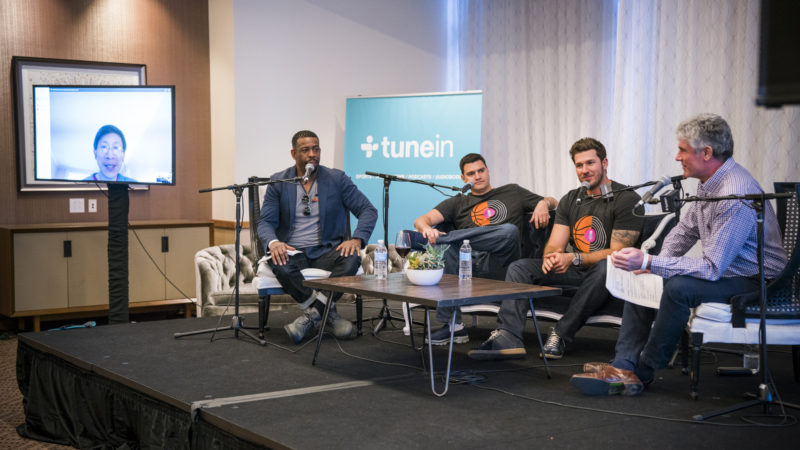May 6, 2017 10:17 pm
Have you listened to Playing with Science’s first “exhibition game” yet?
After Playing with Science completed our pilot season, we enjoyed a very brief off-season of a couple of weeks, and then we went right into our next “pre-season”, where, just like Major League Baseball, we scheduled a series of “exhibition games.” Instead of spring training in Florida, though, we headed on down to Austin, Texas, to the SXSW Festival. There, thanks to our friends at TuneIn, our hosts Gary O’Reilly and Chuck Nice sat down with the hosts of a couple of TuneIn sports podcasts and a couple of famous athletes to record a series of special, promotional podcasts.
Not surprisingly, our first show was with the host of MLB on TuneIn, Holden Kushner, and JP Arencibia, the former Toronto Blue Jays catcher who holds the team record for most home runs. You may not know this, but JP is one of the few players in history to pitch, catch, and hit in the same game, not to mention the fact that on his first at bat in the major leagues, he hit a home run.
The whole point of Playing with Science is to explore the science inherent in sports, and for this particular episode, Chuck and Gary asked series regular astrophysicist Charles Liu to call in via Skype to handle the physics side of the conversation.

Physics at the Plate, LtoR: Charles Liu, Chuck Nice, Holden Kushner, JP Arencibia, Gary O’Reilly. Credit: TuneIn.
If you’ve been a StarTalk fan for any length of time, you’re probably already familiar with the chemistry between the “two Chucks.” But that was nothing compared to the way Charles Liu and JP Arencibia meshed. Together, they dove deeply into the physics of hitting, pitching, and catching. They discussed the differences between aluminum and wooden bats, why denser wood favors power hitters, and what makes the “sweet spot” so sweet. Charles explained how elasticity and compression work to transfer more energy from the bat to the ball, and why predicting exit velocities is so hard to do. Turning to pitching, Charles and JP discussed the rising fastball, which physics says is impossible but baseball fans can swear they see all the time. They talked about what makes breaking balls break, and how scuffing the ball can add 2 extra inches of movement to a cutter. And when it comes to catching, Charles explained how catchers have less than half a second to react to a 90 mph fastball, and JP explained how catchers use trickery and guile to get a batter to chase a less-than-perfect pitch and to keep the opposing team from knowing what pitches they call.
There’s so much more to this episode than that, though, and you can listen to Baseball: Physics at the Plate right now here on our website, or head on over to TuneIn and listen there. (NOTE: If you’re reading this on mobile and you click on the TuneIn link, it will automatically download the free TuneIn player if you don’t already have it.)
We’ll have another of our “pre-season” exhibition games with the folks from TuneIn this Wednesday. Until then, if you’re enjoying Playing with Science, you can help us get ready for next season by subscribing to Playing with Science wherever you listen to podcasts. You can listen on TuneIn, of course. But you can also subscribe on Apple Podcasts, Stitcher, SoundCloud, and GooglePlay Music.
That’s it for now. Keep Looking Up!
–Jeffrey Simons
Get the most out of StarTalk!
Ad-Free Audio Downloads
Priority Cosmic Queries
Patreon Exclusive AMAs
Signed Books from Neil
Live Streams with Neil
Learn the Meaning of Life
...and much more

 Become a Patron
Become a Patron

